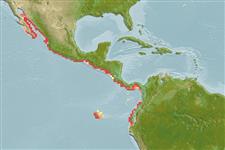Actinopterygii (ray-finned fishes) >
Clupeiformes (Herrings) >
Engraulidae (Anchovies) > Engraulinae
Etymology: Anchovia: Italian ancioa = anchovy (Ref. 45335).
Environment / Climate / Range
Ecology
Marine; brackish; pelagic-neritic; depth range 0 - 50 m (Ref. 189). Tropical, preferred ?; 30°N - 5°S, 115°W - 76°W (Ref. 189)
Eastern Pacific: Magdalena Bay, Baja California on the Pacific coast and from San Felipe Bay, Gulf of California south to Gulf of Guayaquil, northern Peru.
Length at first maturity / Size / Weight / Age
Maturity: Lm ?, range 11 - 11 cm
Max length : 25.0 cm TL male/unsexed; (Ref. 96339); common length : 12.5 cm SL male/unsexed; (Ref. 9298); max. published weight: 57.40 g (Ref. 91172)
Dorsal
spines
(total): 0;
Anal
spines: 0;
Anal
soft rays: 26 - 29. Snout moderate, pointed, tip at or just above eye center; maxilla moderate, tip pointed and reaching onto pre-operculum (but not beyond), extending beyond second supra-maxilla; sub-operculum with a distinct triangular projection on hind margin; lower gill rakers fine and slender, increasing in larger fishes. Silver stripe along flank ,probably disappearing in larger fishes.
Occurs inshore along sandy beaches and in tide streams, forming large schools. Juveniles to about 7 cm occur on beaches and in bays, thereafter moving further from the shore. Feeds by filtering phytoplankton and zooplankton.
Spawn in school (Ref. 205).
Whitehead, P.J.P., G.J. Nelson and T. Wongratana, 1988. FAO Species Catalogue. Vol. 7. Clupeoid fishes of the world (Suborder Clupeoidei). An annotated and illustrated catalogue of the herrings, sardines, pilchards, sprats, shads, anchovies and wolf-herrings. FAO Fish. Synop. 125(7/2):305-579. Rome: FAO. (Ref. 189)
IUCN Red List Status (Ref. 115185)
CITES (Ref. 94142)
Not Evaluated
Threat to humans
Harmless
Human uses
Fisheries: minor commercial; bait: usually
More information
ReferencesAquacultureAquaculture profileStrainsGeneticsAllele frequenciesHeritabilityDiseasesProcessingMass conversion
Tools
Special reports
Download XML
Internet sources
Estimates of some properties based on models
Phylogenetic diversity index (Ref.
82805): PD
50 = 0.6250 [Uniqueness, from 0.5 = low to 2.0 = high].
Bayesian length-weight: a=0.00550 (0.00351 - 0.00861), b=3.20 (3.07 - 3.33), in cm Total Length, based on LWR estimates for this species & (Sub)family-body (Ref.
93245).
Trophic Level (Ref.
69278): 2.7 ±0.30 se; Based on food items.
Resilience (Ref.
69278): High, minimum population doubling time less than 15 months (Preliminary K or Fecundity.).
Vulnerability (Ref.
59153): Low to moderate vulnerability (25 of 100) .
